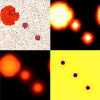Exploiting ecological principles to better understand cancer progression and treatment
- PMID: 24511383
- PMCID: PMC3915838
- DOI: 10.1098/rsfs.2013.0020
Exploiting ecological principles to better understand cancer progression and treatment
Abstract
A small but growing number of people are finding interesting parallels between ecosystems as studied by ecologists (think of a savannah or the Amazon rainforest or a coral reef) and tumours. The idea of viewing cancer from an ecological perspective has many implications but, basically, it means that we should not see cancer just as a group of mutated cells. A more useful definition of cancer is to consider it a disruption in the complex balance of many interacting cellular and microenvironmental elements in a specific organ. This perspective means that organs undergoing carcinogenesis should be seen as sophisticated ecosystems in homoeostasis that cancer cells can disrupt. It also makes cancer seem even more complex but may ultimately provide insights that make it more treatable. Here, we discuss how ecological principles can be used to better understand cancer progression and treatment, using several mathematical and computational models to illustrate our argument.
Keywords: cancer; ecology; heterogeneity; homoeostasis; interactions; mathematical model.
Figures






References
-
- Shapiro F. 2006 The Yale Book of Quotations. New Haven, CT: Yale University Press.
-
- Paget S. 1896. The surgery of the chest. London, UK: John Wright.
Publication types
Grants and funding
LinkOut - more resources
Full Text Sources
Other Literature Sources

